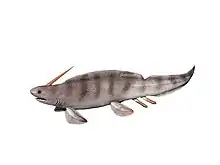Xenacanthus
Xenacanthus is a genus of prehistoric sharks. The first species of the genus lived in the later Devonian period, and they survived until the end of the Triassic, 202 million years ago. Fossils of various species have been found worldwide.
| Xenacanthus | |
|---|---|
 | |
| Impression of the head and body of X. sessilis at the Museum für Naturkunde, Berlin | |
| Scientific classification | |
| Kingdom: | Animalia |
| Phylum: | Chordata |
| Class: | Chondrichthyes |
| Order: | †Xenacanthida |
| Family: | †Xenacanthidae |
| Genus: | †Xenacanthus Beyrich, 1848 |
| Type species | |
| Xenacanthus decheni | |
| Species | |
|
See text | |
| Synonyms | |
|
Pleuracanthus Agassiz 1837 | |

Description

Xenacanthus had a number of features that distinguished it from modern sharks. This freshwater shark was usually about one meter (3.3 feet) in length,[1] and never longer than 2 m (6.6 ft).[2] The dorsal fin was ribbonlike and ran the entire length of the back and round the tail, where it joined with the anal fin. This arrangement resembles that of modern conger eels, and Xenacanthus probably swam in a similar manner. A distinctive spine projected from the back of the head and gave the genus its name. The spike has even been speculated to have been venomous, perhaps in a similar manner to a sting ray. This is quite plausible as the rays are close relatives to the sharks. The teeth had an unusual "V" shape, and it probably fed on small crustaceans and heavily scaled palaeoniscid fishes.[3]
As with all fossil sharks, Xenacanthus is mainly known because of fossilised teeth and spines.
Species
- X. texensis
- X. atriossis
- X. compressus
- X. decheni
- X. denticulatus
- X. erectus
- X. gibbosus
- X. gracilis
- X. howsei
- X. laevissimus
- X. latus
- X. luedernesis
- X. moorei
- X. ossiani
- X. ovalis
- X. parallelus
- X. parvidens
- X. ragonhai - Rio do Rasto Formation, Brazil[4]
- X. robustus
- X. serratus
- X. slaughteri
- X. taylori
References
- Gaines, Richard M. (2001). Coelophysis. ABDO Publishing Company. p. 17. ISBN 1-57765-488-9.
- Beck, Kimberley G.; oler-Gijón, Rodrigo; Carlucci, Jesse R.; Willis, Ray E. (December 2014). "Morphology and Histology of Dorsal Spines of the Xenacanthid Shark Orthacanthus platypternus from the Lower Permian of Texas, USA: Palaeobiological and Palaeoenvironmental Implications". Acta Palaeontologica Polonica. 61 (1): 97–117. doi:10.4202/app.00126.2014
- Palmer, D., ed. (1999). The Marshall Illustrated Encyclopedia of Dinosaurs and Prehistoric Animals. London: Marshall Editions. p. 27. ISBN 1-84028-152-9.
- Victor E. Pauliv; Eliseu V. Dias; Fernando A. Sedor; Ana Maria Ribeiro (2014). "A new Xenacanthiformes shark (Chondrichthyes, Elasmobranchii) from the Late Paleozoic Rio do Rasto Formation (Paraná Basin), Southern Brazil". Anais da Academia Brasileira de Ciências. 86 (1): 135–145. doi:10.1590/0001-37652014107612. PMID 24676160.
External links
 Data related to Xenacanthus at Wikispecies
Data related to Xenacanthus at Wikispecies Media related to Xenacanthus at Wikimedia Commons
Media related to Xenacanthus at Wikimedia Commons
